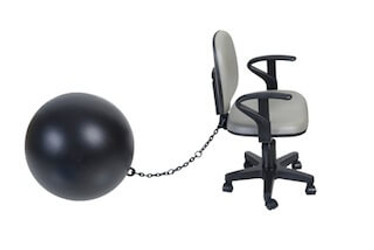Part 2: What’s the Hubbub About Ball Chairs? Are They Really Ergonomic?
Posted by Ian Chong, CPE on 15th Aug 2017
[Editor's note: This is part 2 of a series that began with What’s the Hubbub About Ball Chairs? Are They Really Ergonomic?]
Well, it seems we have stirred up a lot of opinions about this subject. As expected, there are myriad differing view points from our informal task force, as well as some from colleagues sent to me personally.
Here’s what we found:
- everyone had passionate (and I mean passionate) opinions; and
- all opinions were very valid, at least in their own way.
At least one of said stories, anecdotes or case histories were new information to our task force.
To reiterate, we put together a small informal task force made up of some users, Certified and Associate Ergonomists, physical therapists, engineers, occupational therapists, and exercise physiologists -- all professionals and all, not surprisingly, with opinions. We applied a very simple scoring system: +1 is in favor of using a ball as a chair; -1 is not in favor of using a ball as a chair.
Here’s what we uncovered:
Round 1: Scientific studies
Are there any real scientific studies by great people or great universities about the Ball Chairs? Well, yes there are. A couple of colleagues shipped me published articles about Ball Chairs describing how they wired up subjects, male and female, performing various tasks in the Ball chairs while measuring muscle bioelectricity (electromyography -- EMG). The result: the balls show no discernable benefit in reducing specific biomechanical measures during seated task activity and they could not objectively say there was a benefit. But this begs the question, “What in the Bloody ‘ell were you measurin’?” I bet if you measured whatever the young lady I introduced in the last article said felt better, you probably would have found something of significance. Besides, in plain english, the mainstream has no interest in reading scientific journal articles, and likely could not understand them or even know where to find them. So these become less of a reference than the scientific community might think, at least to the casual user.
Scientific Analysis Score: -1
Round 2: Safety
People fall off things. I had a case where an office chair back locked loose - the worker came in Monday morning, leaned against the chair back and fell over backwards, hitting her head against a cast iron radiator fracturing a cervical vertebrae. This could also happen in a ball chair, which does not have a back… resulting in an injury directly attributable to the lack of safety interface. In fact, other Ergoweb readers have shared accidents involving ball chairs at their facilities, as well. No Good. The ball chair can pop, deflate or roll off its stand, quickly leaving the user in a precarious, unbalanced, unforeseen posture allowing an accident. Again no good.
Safety Score: -1
Round 3: User Perception
“If it works for me then to blazes what everyone else thinks. I’m going to use it because it makes me feel better than any $1500 chair could ever do.”
You can’t argue with success, even if it is subjective and perception only - especially if it does something unique (according to the user). Non-objective findings, subjective success and real pain reduction have all posed powerful arguments for the implementation of many things throughout history, including talisman, voodoo, wives tales, folklore medicine, color theory and herbal medicine. And guess what - there are many in the scientific world believing in this subjective aspect of the real world. If it works do it - if it is perceived as good, do it - as long as it works, even on a placebo effect and does not create other issues or additional problems or compromises the safety of the user.
User Perception Score: +1
Round 4: Individual Usage & Knowledge of Usage
“I don’t have any problem sitting on a ball. It’s taken away my back and leg pain. I can rock back and forth, roll around, bounce up and down, exercise my legs and have an inherent sense of balance so I won’t ever fall off. I just don’t understand why everyone doesn’t like one of these balls. Besides, all the fitness gurus say they help develop the core muscles and God knows we all need strong core muscles”.
Sure, you are one of the few who can really use a ball for a seating device to its utmost. You can balance. You can sit upright for eight hours, exercise your core all day long and have fun bouncing up and down all day long manipulating that spreadsheet on your computer.
Just be careful while your mind is multitasking, make sure if the balloon does pop that your razor sharp instincts allow you to recover your balance so you don’t crack your head open when you do suddenly fall over and hit the floor with your skull.
Individual Usage & Knowledge of Usage in Specific Conditions score: +1
Round 5: New cutting edge technology?
"It is sooo cool, it’s new wave, It’s new thinking, It’s seen on TV ('so you know it’s got to be good') and it’s so logical it took away my pain."
There’s absolutely nothing wrong with embracing new technology, especially when it comes to health care. After all, when you really think about it, some aspects of Ergonomics cross-over with the health care business. Being aware of new thinking and new applications is a good thing, but like many things in healthcare, reckless overall widespread use can be very detrimental to those with inappropriate application. After all, I could give you the best ergonomic tool in the world, but if if you use it wrong, it's no longer ergonomic.
New Thinking Score: +1
Round 6: Overall does it really replace a good task chair?
Total and unanimous on this front: NO. Not enough objective findings to sway the jury on this thought. Most importantly the question arises that could this be the beginning of a new movement on a way to the future and could it be possible that the ball chair might potentially become a mainstream item used by the masses, like a newfangled hi-tech toy that no one has the future insight to predict? At the moment mass usage is likely a no (from pure biomechanical means).
Does it Replace a Good Task Chair? Score: -1
Conclusion
These are the six viewpoints in the main consideration.
Scientific Analysis Score: -1
Safety Score: -1
User Perception Score: +1
Individual Usage & Knowledge of Usage in Specific Conditions score: +1
New Thinking Score: +1
Does it Replace a Good Task Chair? Score: -1
Obviously, it’s a tie. So Dear Reader is there anything you feel we should address with our little task force, before we invite you to witness our overall conclusion in our next column? Let me know and we’ll be sure to address it. Our final installment...Conclusion: What’s the Hubbub About Ball Chairs? Are They Really Ergonomic?]
Ian Chong, a Certified Professional Ergonomist with Seattle based multi-disciplinary Extreme Ergonomics Inc., designs and prototypes unique tools, equipment and workstations addressing occupational injuries in all occupational environments, industrial and office on a national level. Ian holds advanced degrees in Ergonomics & Occupational Biomechanics, Industrial Design; and Architectural Engineering, and is also profiled in the Oregon Museum of Science and Industry.
Originally published on ergoweb.com February 2, 2011.

